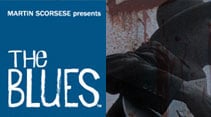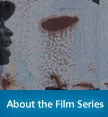





 |
 |
 |
 |
 |
 |
        
|
This relationship between the sacred and the profane is the theme of Warming by the Devil's Fire. It tells the story of a young kid going back to Mississippi before he's twelve to get baptized. To get saved. But then he's kidnapped by his uncle Buddy — a blues person — who takes him around to experience what he's gonna be saved from. At the end, his other uncle, a preacher named Flem, finds him and puts him on the road to the mourner's bench. And years later, Uncle Buddy also ends up becoming a preacher. When we started this project, I screened a lot of footage on the blues; if I hadn't, I probably would have made a relatively conventional documentary. But after seeing so many others, I began to think what could I add? How is this going to be different? I also had to consider how to frame the film — because there's so much to the blues, what do you include, who do you exclude? It took quite a while for me to sort these questions out, which must have frustrated Marty Scorsese. The story I chose for Warming by the Devil's Fire isn't strictly autobiographical, but everything in the film happened to a certain extent, and I used these experiences as guideposts to come up with a story that everyone could identify with. I had an uncle who was very much like Buddy. Like the trickster figure in folklore, Buddy awakens things in his nephew and gives him experiences that will help him become a complete person. At the same time, I wanted to tell a story about the blues that echoed the form. There's play within the material; it tries to be loose. And the character played by Tommy Hicks — Uncle Buddy — personifies the feeling of the blues and embodies all of its contradictions. The story's told from the perspective of the narrator, the young kid who returns to Mississippi and becomes aware of the blues as an art form. It's through his eyes that we, the audience, meet the blues. It's through his ears that we listen to the blues and come to appreciate them. The film includes a wide range of music, from raw gutbucket blues to the more sophisticated R&B, and is representative of both male and female singers. I wanted to put the music in context, too. The blues came out of the South, and the South has its history of struggles, and it seemed to me you can't really separate the blues from their historical context: how people lived, the hardships they experienced, the texture of their daily lives — it was all related. I was looking for things that spoke to that period, that conveyed the harshness, the humor, and the contradictions. For example, we use a lot of footage of the horrible flood that devastated that part of Mississippi. Lives were lost. The whole economy was damaged. We showed the levee camps that sprang up as a result — another tragic period in the history of black labor. We used chain-gang images. For a black person in the South at the time, it didn't take very much to go to jail. You didn't have to do a serious crime — just look the wrong way. Out of those experiences came the elements for the blues. The blues encompasses every emotion; people listen to the blues because the blues allows one to come to terms with basic instincts. And it speaks to the circumstances for blacks of an earlier time. When you look at the atmosphere surrounding the blues — racism, hard work and little to show for it; exploitation, humiliation, and the explosive life at the juke joint, where shootings and knife fights were not uncommon — you get a picture of survival and the will to live and self-destruct at the same time. I also wanted to include images that were in themselves moving, visual, cinematic. I really admire a work by James Agee called Now Let Us Praise Famous Men. He and Walker Evans went across the South and documented workers — black and white — during the Depression. What made that book remarkable was that it provided this sense of history told from a certain perspective. Yet Agee was also concerned about exploiting the subject; he wanted to be as objective as possible. The result was a document that gives a feeling of the period that would have been lost otherwise. That's one of the things I was trying to achieve — to go beyond information and convey a feeling for how these people lived and how they felt. I grew up playing the trumpet, so W.C. Handy's music was the beginning; his were the first blues I learned how to play. Handy wasn't your typical vagabond blues player, like Robert Johnson and Blind Lemon Jefferson, traveling with a guitar on his back to find work on the street corners. Handy came from a middle-class family, which was unusual. His father wanted him to go to college and didn't think music was any way to make a living. But Handy had a lot of things going for him — he was one of the first African-Americans to write and publish his own material. He followed his own dreams, went against his parents' wishes, and ended up being successful. Handy went blind, then his sight came back, and finally he went permanently blind. I've always been interested in people who have to overcome a handicap like blindness, like Blind Lemon Jefferson, who managed to survive, hopping trains and singing in levee camps, the worst and most dangerous places to work, where there wasn't any law. That he was able to be imaginative and creative and have a sense of poetry under those circumstances is remarkable. His music and lyrics are incredibly moving, but the things he sings about are things you only want to experience vicariously. During one scene in the film, Buddy plays a record by Lucille Bogan, a singer whose lyrics were very graphic sexually. Her records should be double X-rated, in fact, her first release was too raw to be released. When she sings about "nipples on my titties as big as the end of your thumb" and on and on, you get a clear sense of why the church was so opposed to the blues. On the other hand, Lucille Bogan can be seen as an important figure in that she was unabashed about her sexual desire at a time long before the so-called "sexual revolution." Bogan, Mamie Smith, Ma Rainey, Bessie Smith — these were women at the top of their game creatively who dealt openly with women's themes and issues. Choosing the music was the hardest part — because there was so much great material to choose from. Every time I came back to the film, I'd wind up choosing another piece of music. To really get a sense of the blues, you'd need to do the impossible, by putting everything in. I chose a Sonny Boy Williamson song, for example, because he's a great singer/harmonica player, of course — but also because he was a character himself, someone with a great screen presence. When you do a film, you always have to consider casting. There were some wonderful musicians we could have used who, unfortunately, weren't as cinematically engaging. A lot of people who were essential to this era probably should have been included for historical reasons, but for dramatic reasons I wound up leaving them out. Movies don't allow for any lulls. So you go for the personality, what works well on the screen. I wanted to have more of Bessie Smith and Billie Holiday in the film, in fact more of everyone. Especially the women, who came from vaudeville, which meant they had more professional training, as opposed to someone like Robert Johnson, who migrated and picked up things as he went. The early women singers had a big impact on the blues, particularly because of their record sales. They had huge audiences and helped spread the blues. The women had a unique role. —Charles Burnett Read an archived version of Charles Burnett's Washington Post online chat.
|
 |
|
|
|
Home | About the Film Series | The Songs & The Artists | Blues Road Trip | Film & Television | DVD & CD Collection | Press Info | Credits |